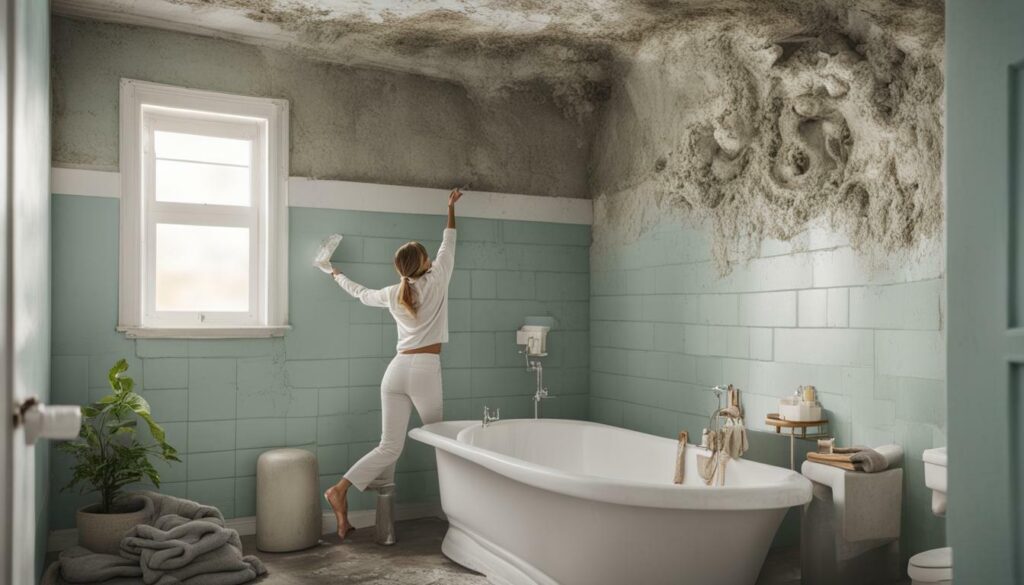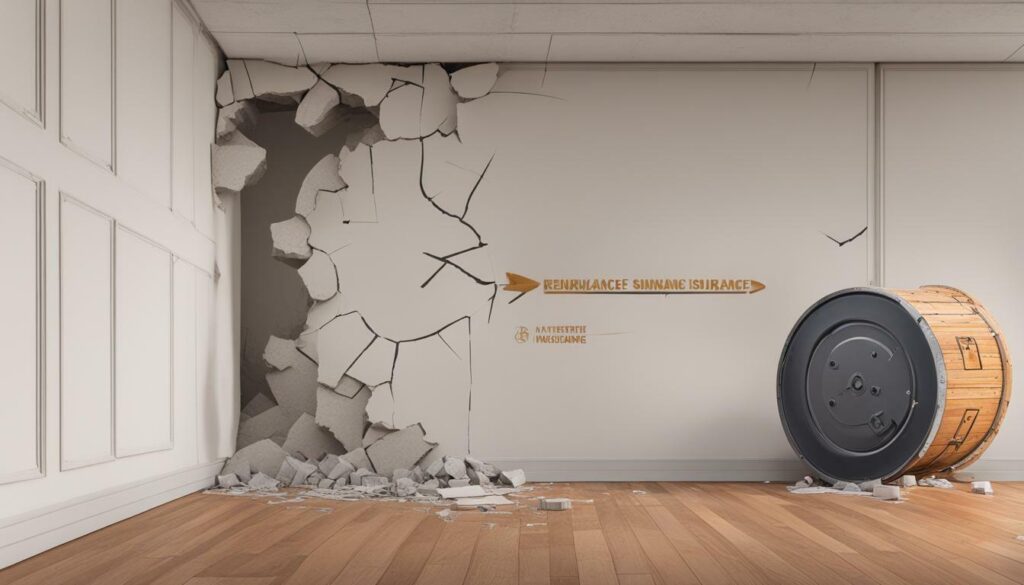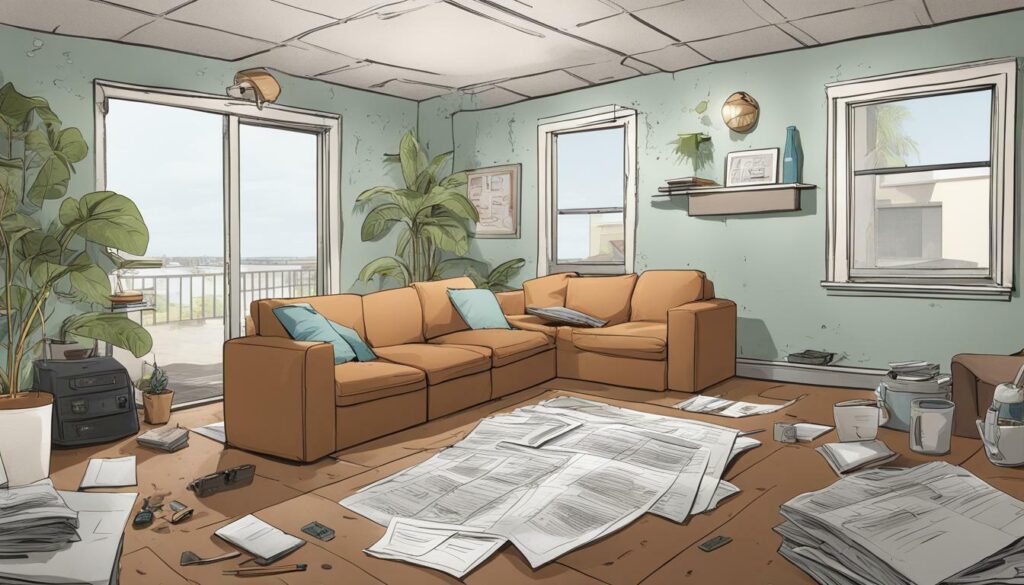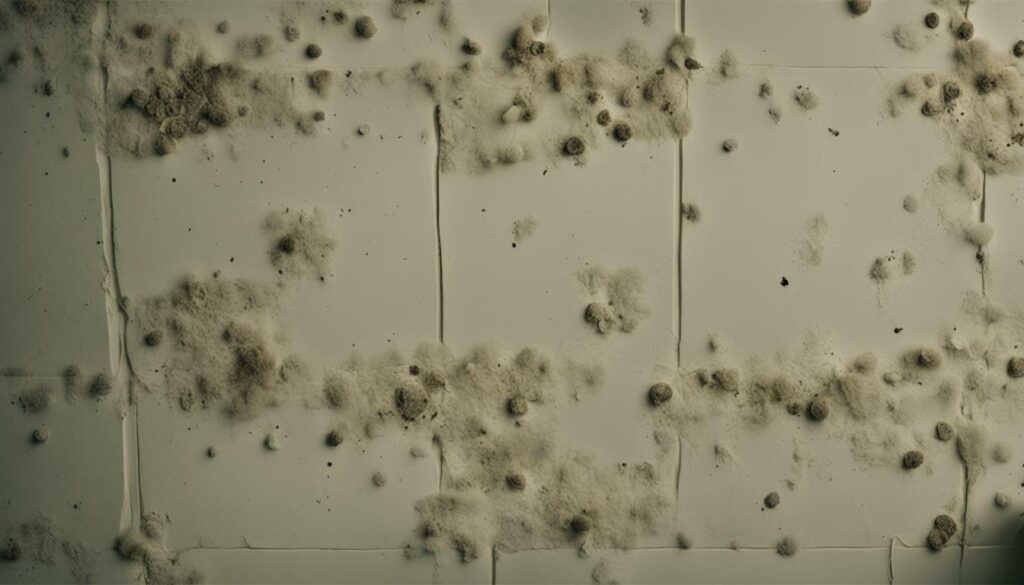As a renter, you want to ensure that you are protected if anything goes wrong with your rental property. Mold growth in the bathroom is a common problem that can cause property damage and health issues. So, you may wonder if your renters insurance covers you in case of mold growth in the bathroom. Let’s explore the different factors that can affect your renters insurance coverage for mold in the bathroom.
Key Takeaways:
- Renters insurance policies typically provide coverage for mold damage, but some exclusions may apply
- Mold remediation and cleanup costs may or may not be covered by renters insurance, depending on the policy and the cause of the mold growth
- Preventive measures can help you avoid mold growth in your bathroom and minimize the risk of property damage and health issues
Understanding Renters Insurance Coverage
As a renter, it’s important to understand what your insurance policy covers and how it can protect you from unexpected damages or losses. When it comes to mold damage in your bathroom, your renters insurance policy may offer coverage, but it depends on the specific terms and conditions of your policy.
Renter’s insurance policies typically provide coverage for damages caused by certain perils, such as fire, theft, vandalism, and water damage from burst pipes or other accidental sources. However, mold damage may not always be covered by default, as it can be caused by a variety of factors that may or may not be included in your policy’s coverage.
If you’re concerned about mold damage in your bathroom and want to ensure you have adequate protection, you should review your policy documents and speak with your insurance provider to understand exactly what is covered and what is not.
What Does Renters Insurance Cover?
Generally speaking, renters insurance policies provide coverage for personal property, liability, and additional living expenses in the event of a covered loss. Personal property coverage helps to repair or replace your belongings if they are lost or damaged due to a covered event, such as theft or fire. Liability coverage can help protect you if you are held responsible for causing damage to someone else’s property or if someone is injured on your rental property. Additional living expense coverage can help pay for temporary housing and other expenses if you have to temporarily vacate your rental property due to a covered loss.
Some renters insurance policies may also offer added protection for specific types of perils, such as earthquakes or floods, but these are typically offered as additional riders or endorsements that you can add to your policy for extra coverage.
Does Renters Insurance Cover Mold?
Whether or not renters insurance covers mold damage in your bathroom depends on the specific terms and conditions set forth in your policy. In general, renters insurance policies may provide coverage for mold damage if it is caused by a covered peril, such as water damage from a burst pipe or appliance malfunction. However, mold damage that results from long-term neglect or unaddressed maintenance issues may not be covered by your policy.
To determine whether or not your policy covers mold damage in your bathroom, you should review your policy documents carefully and speak with your insurance provider to clarify any questions or concerns you may have. If your policy does not provide adequate coverage for mold damage, you may want to consider adding an additional endorsement or rider to your policy to provide extra protection.
Overall, understanding your renters insurance policy and the coverage it provides is essential to protecting yourself and your rental property from unexpected damages or losses. Take the time to review your policy and speak with your insurance provider to ensure you have the right amount of coverage for your needs, including protection against mold damage in your bathroom.
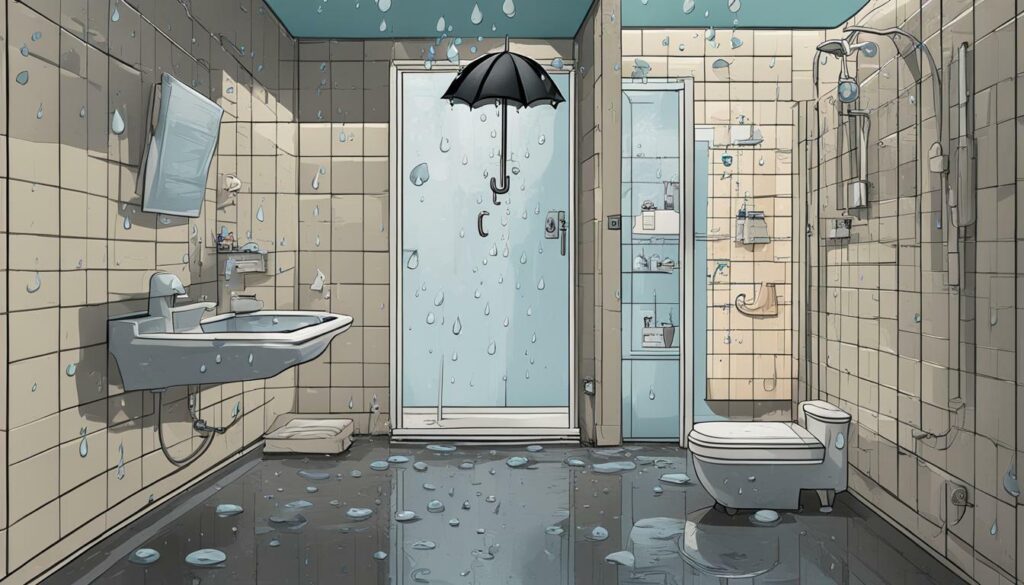

The Causes of Mold in Bathrooms
When it comes to mold damage and renters insurance, it’s important to understand the causes of mold growth in the bathroom. Mold thrives in warm and humid environments, which are often found in bathrooms that lack proper ventilation. Common causes of mold growth in the bathroom include:
- Leaky pipes or faucets that create moisture buildup
- Poor ventilation or lack of air circulation
- Excessive humidity from hot showers or baths
- Damp towels or bath mats that aren’t dried properly
Mold is not only unsightly but can also lead to serious health issues such as allergies, respiratory problems, and even infections. As a renter, it’s your responsibility to take necessary precautions to prevent mold growth in your bathroom and minimize the risk of property damage and health hazards.


However, even with proper precautions, mold growth can still occur in your bathroom. If you notice mold damage in your rental unit, it’s important to take immediate action to prevent further damage and protect your health.
In the next section, we’ll discuss the specific policy exclusions for mold in renters insurance and what renters should do if they need to file a claim.
Mold Exclusions in Renters Insurance Policies
While renters insurance provides coverage for a wide range of damages and incidents, it’s important to note that there may be exclusions for certain types of damage, including mold in the bathroom. Mold exclusions are not uncommon in renters insurance policies, and they can limit or completely exclude coverage for mold-related expenses.
Most renters insurance policies cover sudden and accidental water damage, which can lead to mold growth if not addressed promptly. However, if the mold growth is due to prolonged humidity or moisture, your insurance provider may consider it a maintenance issue and deny coverage.
Additionally, some renters insurance policies may limit the amount of coverage for mold-related expenses, leaving you with out-of-pocket costs for remediation and cleanup. It’s important to review your policy carefully and understand the specific mold exclusions and limitations before filing a claim for mold damage in your bathroom.
If you’re uncertain about your coverage for mold in the bathroom, consider contacting your insurance provider or agent for more information. They can provide you with specific details about your policy and any optional endorsements or add-ons that may provide additional coverage for mold damage in your rental unit.
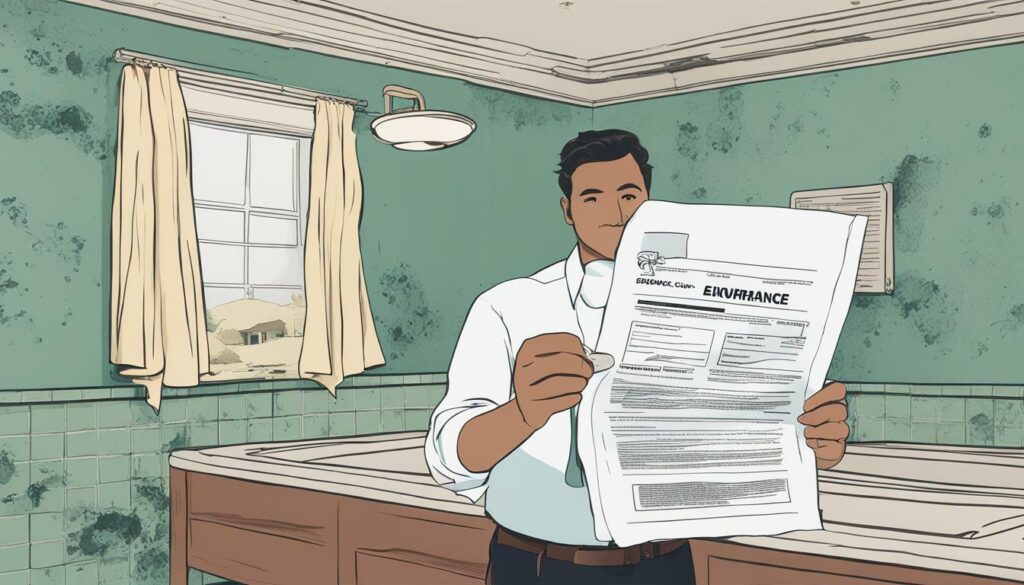

Mold Remediation and Cleanup Costs
If you discover mold in your bathroom, you may be wondering about the costs of remediation and cleanup. The truth is, mold removal can be expensive, and the costs may not be covered by your renters insurance policy.
However, if the mold was caused by a covered peril, such as a burst pipe, your renters insurance policy may cover the costs of mold remediation and cleanup.
| Expense | Average Cost |
|---|---|
| Mold Inspection | $200-$600 |
| Mold Remediation | $500-$6,000 |
| Bathroom Repair | $1,000-$5,000 |
If you plan to file a renters insurance claim for mold damage, it’s important to document the damages and provide evidence for the claim process. This may include photos of the mold growth, receipts for any expenses related to remediation and cleanup, and any correspondence with your landlord or property manager.
Keep in mind that filing a renters insurance claim for mold may result in higher premiums or non-renewal of your policy in the future.
It’s important to take preventative measures to minimize the risk of mold growth in your bathroom. Regularly cleaning and ventilating your bathroom, fixing leaks and plumbing issues promptly, and using mold-resistant products can all help prevent mold growth.
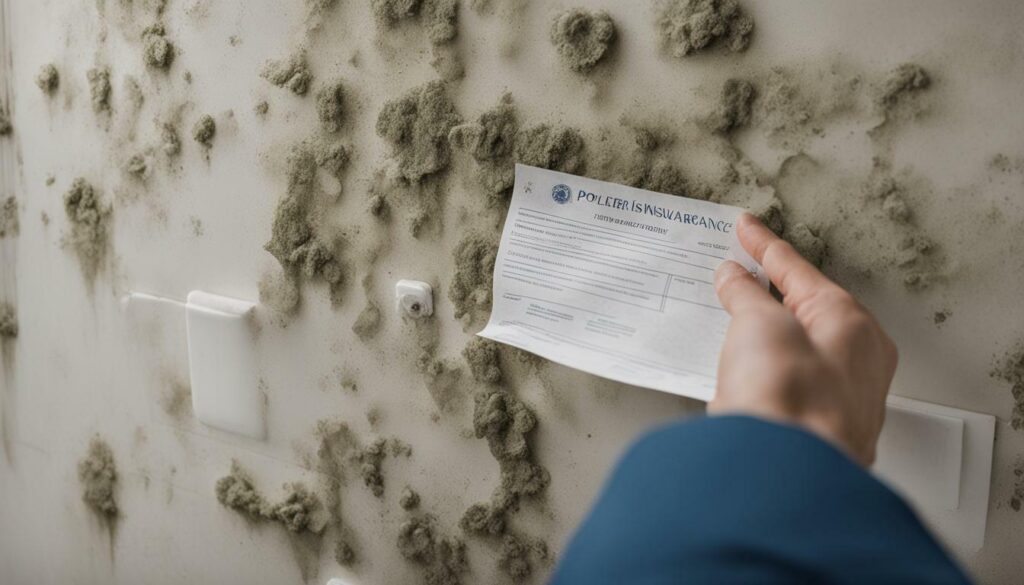

Additional Coverage Options for Mold
While renters insurance policies typically provide limited coverage for mold damage, you may be able to purchase additional coverage options to enhance your protection against this type of loss. Depending on your insurance provider, these optional endorsements may include:
| Endorsement | Description |
|---|---|
| Mold Remediation Coverage | This endorsement offers broader coverage for mold damage, including the cost of removing and cleaning up mold in your bathroom. It may also cover any necessary repairs to your property that are required to prevent further mold growth. |
| Water Damage Coverage | Since water damage is often a root cause of mold growth, this endorsement provides coverage for expenses related to water damage, including repairs to damaged pipes or appliances that caused the water damage. |
Keep in mind that these additional coverage options may come with a higher premium, so be sure to weigh the cost vs. benefit before making a decision. You may also want to consult with your insurance agent to determine which coverage options make the most sense for your situation.
Note: Not all insurance providers offer these endorsements, and coverage may vary by state and policy. Be sure to review your renters insurance policy and endorsements carefully to understand your coverage.


Steps to Take When Discovering Mold in Your Bathroom
If you notice mold in your bathroom, it’s important to act quickly to prevent further damage and potential health issues. Here are the steps you should take:
- Notify your landlord: If you’re renting your home, the first thing you should do is let your landlord know about the mold. They may have specific procedures in place for handling mold remediation.
- Document the damage: Take photos and videos of the mold damage in your bathroom, as well as any personal property that has been affected. This documentation will be important for filing an insurance claim, if necessary.
- Contact your renters insurance provider: Review your renters insurance policy to see if it covers mold damage in the bathroom. If it does, file a claim with your provider. Be sure to have your documentation ready to provide evidence of the damage.
- Get professional mold remediation: Hire a licensed mold remediation company to assess the damage and safely remove the mold. Do not attempt to clean up the mold yourself, as this can be dangerous and may not effectively solve the problem.
By following these steps, you can take control of the situation and protect yourself from any further harm. Remember, the key is to act quickly and not let the problem go unaddressed.


Documenting Mold Damage for Insurance Claims
If you discover mold in your bathroom, the next step is to file an insurance claim with your renter’s insurance provider. However, it’s important to document the extent of the mold damage properly to ensure that your claim is processed more efficiently.
Start by taking photos or videos of the affected area. Capture the mold growth, water damage, and any other visible signs of mold. This evidence serves as proof of the mold damage and can help support your claim.
It’s also essential to keep all receipts and documents related to the mold remediation process, including invoices from the professionals who remove the mold.
Note that renting a mold testing kit may not be enough for evidence in court or securing an insurance claim for mold damage. Your insurance company may hire their inspector to check mold damage.
Be sure to provide your insurance company with accurate and complete documentation of the mold damage to ensure that your claim is processed quickly and efficiently.
Tips for Preventing Mold in Your Bathroom
If you want to avoid dealing with mold in your bathroom and potential renters insurance claims for mold, there are several preventive measures you can take. Here are a few tips:
- Use an exhaust fan or open a window when showering or bathing to reduce humidity and moisture.
- Dry off your bathtub, shower walls, and fixtures after each use to prevent water buildup.
- Fix any leaks in your bathroom promptly, including drippy faucets or pipes.
- Regularly clean and disinfect your bathroom surfaces, including the tub, shower, sink, and toilet.
- Use mold-resistant paint or wallpaper in your bathroom to prevent mold growth on surfaces.
- Replace any cracked or damaged tiles in your bathroom to stop moisture from seeping through and creating mold growth.
- Consider purchasing a dehumidifier for your bathroom if you live in a particularly humid location or have limited ventilation.
By following these tips, you can proactively reduce the risk of mold growth in your bathroom. However, if you do discover mold in your bathroom despite your best efforts, be sure to take swift action to minimize the damage and seek renters insurance coverage if necessary.


Final Thoughts on Renters Insurance and Mold in Bathrooms
After reading this article, you should have a better understanding of how renters insurance protects you from mold damage in the bathroom.
Remember that while renters insurance typically covers mold damage, there may be specific exclusions and limitations in your policy that you need to be aware of. It’s important to review your policy carefully and ask your insurance provider any questions you may have about your coverage.
If you’re unfortunate enough to discover mold in your bathroom, it’s essential to take immediate action. Notify your landlord and document the damage with photographs, videos, and written descriptions. If necessary, file an insurance claim with your provider.
Additionally, it’s crucial to take preventive measures to prevent mold growth in the first place. Regularly clean and disinfect your bathroom, maintain proper ventilation, and fix any leaks or water damage promptly.
While renters insurance can provide valuable protection against mold in the bathroom, it’s always best to be proactive and take steps to prevent damage before it occurs. By understanding your policy and taking preventive measures, you can protect yourself and your home from the effects of mold damage.


Final Thoughts on Renters Insurance and Mold in Bathrooms
As a renter, it’s important to understand whether your renters insurance policy covers mold in the bathroom. While policies vary, most renters insurance policies provide coverage for mold damage caused by a covered peril, such as water damage from a burst pipe or leaking roof. However, there may be exclusions or limitations to coverage for mold, so it’s crucial to review your policy carefully and speak with your insurance agent if you have any questions or concerns.
Preventing mold growth in your bathroom is the best way to avoid costly property damage and potential health risks. Simple strategies like running the exhaust fan during and after showers, fixing leaks promptly, and keeping the bathroom clean and dry can go a long way in preventing mold growth. If you do discover mold in your bathroom, be sure to document it thoroughly and take the necessary steps to address the issue, such as contacting your landlord and filing an insurance claim if necessary.
Consider additional coverage options or endorsements that may be available to enhance your renters insurance protection against mold damage. As with any insurance policy, it’s important to review your coverage periodically and update it as needed to ensure you have adequate protection.
Conclusion
While renters insurance may provide coverage for mold damage in the bathroom, it’s important to review your policy carefully and take steps to prevent mold growth in the first place. By understanding your insurance coverage and taking proactive measures to maintain a clean and dry bathroom environment, you can protect yourself from costly property damage and safeguard your health and well-being.
FAQ
Q: Does renters insurance cover mold in the bathroom?
A: Renters insurance may provide coverage for mold damage in the bathroom, but it depends on the specific policy. It’s important to review your policy documents or contact your insurance provider to understand the extent of coverage for mold-related issues.
Q: What does renters insurance typically cover?
A: Renters insurance usually covers personal property loss or damage due to covered perils like fire, theft, or water damage. It may also provide liability coverage for accidents that occur in your rented property. However, coverage for mold damage may vary, so it’s important to check your policy.
Q: What are the common causes of mold growth in bathrooms?
A: Mold in bathrooms is often caused by excess moisture, inadequate ventilation, or water leaks. These conditions create an ideal environment for mold spores to thrive, leading to property damage and potential health issues.
Q: Are there mold exclusions in renters insurance policies?
A: Yes, some renters insurance policies may have specific exclusions for mold damage. These exclusions may limit or exclude coverage for mold-related claims. It’s important to review your policy and understand the limitations of coverage for mold.
Q: Does renters insurance cover the costs of mold remediation in bathrooms?
A: Renters insurance typically covers the costs of mold remediation if the mold is a result of a covered peril, such as a burst pipe. However, it’s best to consult your policy or speak with your insurance provider to understand the specific coverage and any deductibles or limits that may apply.
Q: Are there additional coverage options for mold damage?
A: Some renters insurance policies may offer optional endorsements or add-ons to enhance coverage for mold damage. These additional coverages may provide more comprehensive protection against mold-related issues in the bathroom. It’s advisable to discuss these options with your insurance provider.
Q: What should I do if I discover mold in my bathroom?
A: When you discover mold in your bathroom, it’s important to notify your landlord or property manager immediately. They should be made aware of the issue and take appropriate steps to address it. If necessary, you may need to file a renters insurance claim if the mold damage is covered by your policy.
Q: How should I document mold damage for an insurance claim?
A: To document mold damage for an insurance claim, take clear photographs or videos of the affected areas. Keep a record of any correspondence with your landlord or property manager regarding the mold issue. It’s also helpful to gather any receipts or invoices for mold remediation expenses.
Q: What can I do to prevent mold growth in my bathroom?
A: To prevent mold growth in your bathroom, ensure proper ventilation by using exhaust fans or opening windows. Promptly repair any leaks or water damage. Regularly clean and dry surfaces prone to moisture, such as shower curtains and bathroom tiles. Use mold-resistant products where applicable.
Q: What are the final thoughts on renters insurance and mold in bathrooms?
A: Understanding the extent of coverage for mold damage in your renters insurance policy is crucial. Take proactive steps to prevent mold growth in your bathroom and promptly address any issues. By doing so, you can minimize potential property damage and ensure a healthy living environment.
Q: Conclusion
A: Renters insurance coverage for mold in the bathroom can vary depending on the policy. It’s important to review your policy, understand its limitations, and take necessary preventive measures to avoid mold growth. If you encounter mold, notify your landlord and consider filing an insurance claim if applicable. Regular maintenance and good hygiene practices can help keep your bathroom mold-free.

